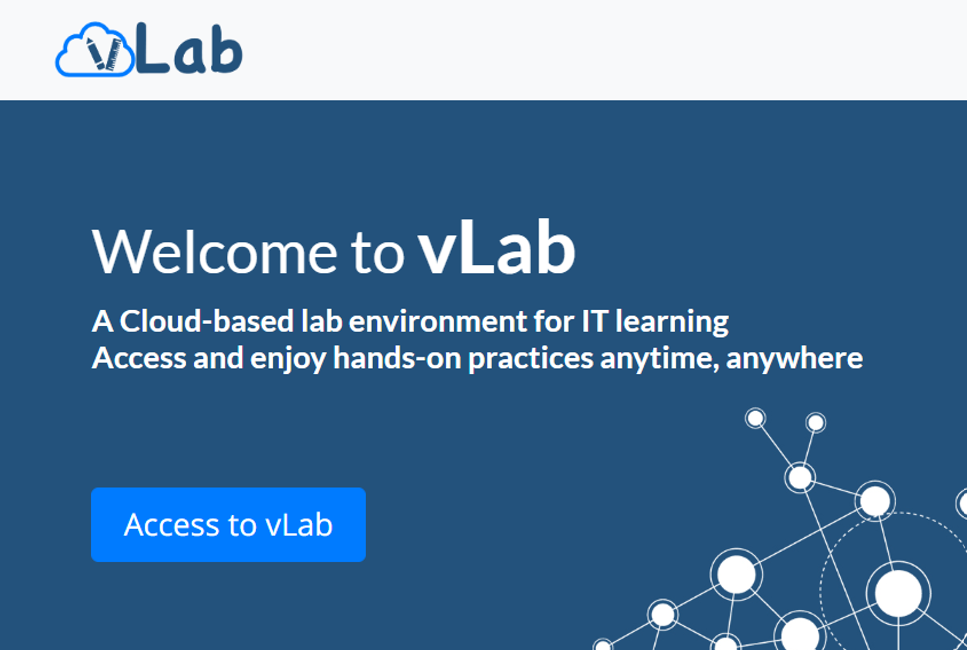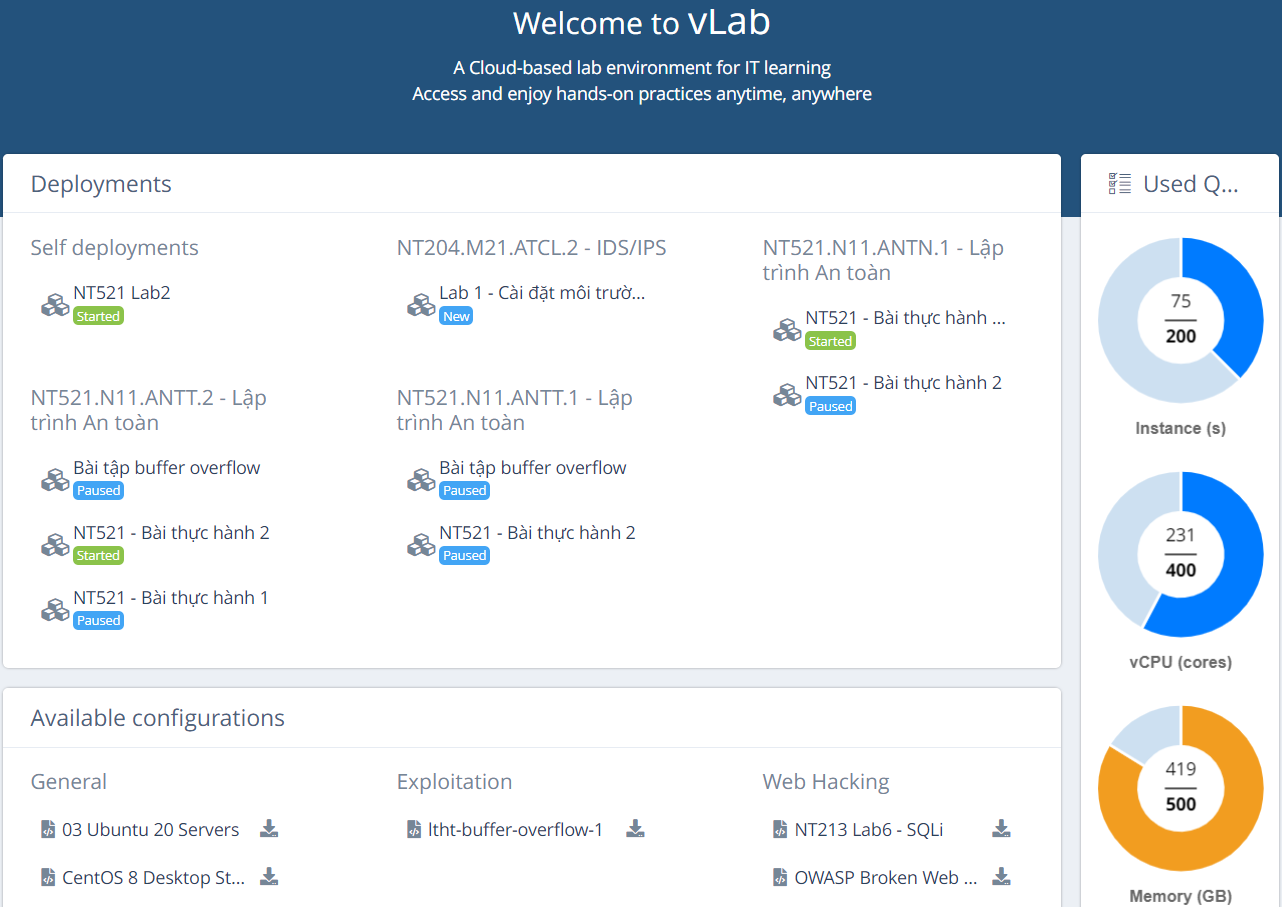vLab – A cloud-based lab environment for IT learning
In the context of Education 4.0, the current traditional practical teaching and learning approach for IT subjects in most universities and training institutions faces challenges. Especially, since 2020, the world has witnessed the outbreak of the Covid-19 pandemic, leading to social distancing policies and the shift of classes to online platforms. This exacerbates the difficulty and limitations of traditional hands-on classes, prompting the urgent need for online systems supporting doing laboratory. These online practical systems or virtual laboratories should enable learners to experience and practice skills as they would on physical equipment without encountering any difficulties.
Meanwhile, online laboratories or teaching environments can be built by means of virtualization cloud computing platforms. In doing so, educational institutions will reap significant benefits in terms of synthesizing learning information and providing useful suggestions and recommendations for both learners and instructors. Through the application of cloud computing, AI, Big Data, and IoT technologies, instructors can collect, analyze, and accurately assess learner data; remotely monitor learning processes, assess task completion levels, and inform learning outcomes to students and their families. Furthermore, automation technology can potentially replace instructors in some administrative tasks such as attendance tracking, grading, lesson preparation, and theoretical teaching support. This enables learners to access standardized curricula tailored to individual competencies without constraints of time and space in their learning process.
In general, the main objectives of a virtual laboratory for IT learning can be summarized as follows.
Remote access support: this feature allows learners to proactively schedule their study time and access the practical environment from anywhere.
Lab exercises customization: lab exercises can be modified conveniently via a friendly GUI to meet the specific requirements of subjects or users.
Course management and evaluation: instructors can create and manage their classes with multiple learners in the form of resource-shared groups, while enabling learning process tracking and automatic evaluation.
1. Functionality
The proposed virtual lab environment – vLab leverages cloud computing platform to provide resources for lab exercise to overcome the weakness of current traditional teaching approach as well as meet the required goals of a virtual laboratory.
In more details, vLab is designed with the following features:
- This system enables users, which can be in the role of instructors or learners, design their own lab exercises: Along with a wide range of pre-defined lab exercises targeting various learning objects and learners, vLab also allows users define their own ones with common OS such as Windows, Linux. Each lab exercise can have one or more virtual machines connected in a network defined by the creator. The feature of defining lab exercise can be performed on a friendly and easy-to-use GUI.
- Automatic, flexible, and rapid lab environment deployment: Once selecting a desired lab exercise, its deployment can be automatically and transparently performed via some steps of configuration, software installation or service settings based on the requirements defined.
- Unlimited access: There is no time and distance barrier in resource access on vLab. Users can access their resources via a web browser without any requirement for additional plug-ins or software.
- Resource sharing and management: System administrators can allocate quotas for instructors and learners for their teaching and learning activities on vLab. Moreover, lab exercises can be deployed for classes of multiple learners. In which, members in the same group of a class can share resources to enable collaboration.
- Evaluation of learning process: Doing lab exercises on a centralized management system allows us to collect performed activities of learners on provided environments, which is useful for learning evaluation.
2. Technical specifications
- vLab is designed to allow users to deploy lab exercise in a rapid and flexible manner. The average time consumption for lab environment deployment should be less than 2 minutes. The deployment should be automatic and transparent to users.
- vLab supports remote access from anywhere, anytime, without the requirement of installing additional plug-ins or software. It should support common web browsers such as Chrome, IE, Firefox, Edge, Safari and is able to respond to 500 users simultaneously.
- vLab is designed as a high-load system with permission control. It should be able to run 1000 virtual machines simultaneously with an average hardware configuration (2-4 cores CPU, 2-8GB memory).
- vLab enables users to define lab exercise with various complexities to meet their specific requirements.
3. Scientific content
vLab leverages the cloud computing platform to deploy network topologies and manage virtual machines for classes automatically. Compared to other current existing virtual laboratories, vLab exposes some outstanding features:
- vLab supports various pre-defined basic images, which is equipped with a common OS and necessary packages/software to be deployable on cloud computing platform. This can simplify the preparation of users to create virtual machines on vLab.
- vLab provides the function of defining lab exercise with a friendly and easy-to-use drag-and-drop GUI.
- vLab deploys lab environment on cloud computing platform automatically and transparently.
- vLab provides a friendly portal for courses, exercises, and resources management.
- Users can access vLab from anywhere, anytime via web browsers without any additional plug-ins or software.
- Courses can be managed in the form of groups of learners or individuals.
4. Product’s technologies
The system utilizes OpenStack to construct cloud infrastructure. OpenStack is an open-source platform that enables the creation of a Cloud Infrastructure as a Service (IaaS). OpenStack consolidates resources in a virtualized manner to build and manage private or public cloud computing. During the virtualization process, resources such as CPU and RAM are abstracted by various programs, divided by hypervisors, and then distributed as needed. OpenStack uses a set of Application Programming Interfaces (APIs) to access resources to serve the cloud computing tasks requested by users and administrators.
In response to the requirements for packages/software to be prepared for virtual machines in a practical scenario, the system employs the automation tool Puppet, which is capable of installing environments for virtual machines. Consequently, the environmental requirements of each virtual machine are represented as Puppet code for installation during the initialization process of these virtual machines. Puppet code automates the tasks of installing and configuring applications and systems for virtual machines. It allows for package installation, command execution, file creation, and user management.
The virtual lab system, vLab, has a cloud infrastructure for deploying virtual machines. These machines are mostly pre-installed with remote control protocols such as SSH and RDP. The objective of the system is to access the virtual machines through a web browser without the need for any additional software. Therefore, the system opts to use Apache Guacamole, a clientless remote desktop gateway. It is termed clientless because it does not require the installation of any plugins or client-side software. Guacamole is installed on the server side, and all clients access the virtual machine’s desktop interface through a web browser. It acts on behalf of the user to connect to remote servers via protocols such as RDP, VNC, and SSH.
5. Value of the product
The system offers a new model for teaching information technology and related fields, meeting the learning needs in an interactive environment accessible anytime, anywhere, without requiring learners to equip themselves with expensive hardware. Moreover, the system is capable of being applied in support of designing and continuously assessing the learning process of students. Furthermore, the product also contributes to changing the methods of teaching and learning, making learners more flexible in their studies.
6. Practical contributions
The vLab virtual lab system has been deployed and applied to support teaching activities at the Faculty of Computer Networks and Communications, University of Information Technology – VNUHCM. To date, the system has served over 1200 users, more than 62 classes, and nearly 1500 practical exercises have been implemented.
7. Technology transfer ability
The proposed vLab virtual lab system features an advanced cloud computing infrastructure, capable of scaling based on hardware resources. Additionally, this virtual lab system is sufficiently capable of deployment to support the creation of practical environments for most subjects at universities, colleges, and information technology training institutions.
8. Ability to cooperate with localities, businesses, and organizations
Hướng nghiên cứu này với tiềm năng ứng dụng cao vào hoạt động giảng dạy và đào tạo có thể thu hút nhiều sự quan tâm đến từ các tổ chức, doanh nghiệp đang cung cấp các khóa học ngắn hạn và dài hạn. Cụ thể, đó chính là khả năng cung cấp một môi trường học tập được ảo hóa phù hợp với nhiều khóa học có những yêu cầu khác nhau.
This research direction, with its high potential for application in teaching and training activities, may attract considerable interest from organizations and businesses offering short-term and long-term courses. Specifically, it involves the ability to provide a virtualized learning environment suitable for many courses with varying requirements.
9. Images



10. Contact
Phạm Văn Hậu
Van-Hau Pham
Faculty of Computer Networks and Communications, University of Information Technology, Vietnam National University – HCM
Quarter 6, Linh Trung Ward, Thu Duc City, Ho Chi Minh City
Email: haupv@uit.edu.vn
2022 Annual Conference
Email: haupv@uit.edu.vn
2022 Annual Conference
